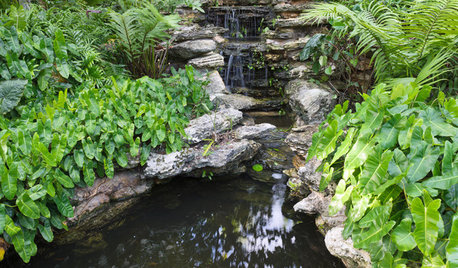Papayas
marcie_new
14 years ago
Related Stories

LANDSCAPE DESIGNRecipe for Tropical Edible Garden Style
Appeal to exotic good taste with fruit trees, palms and tropical look-alikes in your temperate-climate garden
Full Story
COLORNature’s Color Wisdom: Lessons on Yellow From the Great Outdoors
Let the sunshine in. These ways to use yellow will cheer up your interiors and make Mother Nature proud
Full Story
HOUZZ TOURSMy Houzz: A Surf Shack in a Hawaiian Jungle
This Maui artist’s compact home makes room for plenty of creative thinking
Full Story
ORANGEMango: Orange for the Rest of Us
On the fence about decorating with orange? Ease into it with mango, a gentler tone that makes rooms no less striking
Full Story
COLORHow to Choose a Paint Color
Designers offer tips for examining your closet, memories and daily life to find the right paint colors for your home
Full Story
GREEN BUILDINGSunlight Used Right: Modern Home Designs That Harness Solar Power
Embracing passive heating principles through their architecture, siting and more, these homes save energy without skimping on warmth
Full Story
ARCHITECTURE6 Amazing Homes Dug Into the Earth
Designed to disappear or with portions peeking out, these houses bring a new meaning to 'communing with nature'
Full Story
TROPICAL STYLEMy Houzz: New York Chic and Laid-Back Hawaiian Style on Maui
A relocating New Yorker designs an island home influenced by her former city life
Full Story
GARDENING FOR BUTTERFLIESBring on the Birds: Natural Habitat Ideas for Gardens of All Sizes
Provide nesting, watering and perching spots inspired by the Costa Rican jungle and watch the birds flock on over
Full Story
REMODELING GUIDES10 Design Features to Kick Your Remodel Up a Notch
You’ve done the legwork on your home renovation or new build. Now it’s time to plan your reward
Full Story








karyn1
Related Professionals
Benbrook Landscape Architects & Landscape Designers · Clemson Landscape Architects & Landscape Designers · Essex Landscape Architects & Landscape Designers · Simi Valley Landscape Architects & Landscape Designers · Willowick Landscape Architects & Landscape Designers · Cupertino Landscape Contractors · Fairhope Landscape Contractors · Firestone Landscape Contractors · Lady Lake Landscape Contractors · Mastic Beach Landscape Contractors · Pleasanton Landscape Contractors · Ramsey Landscape Contractors · Sammamish Landscape Contractors · Tinton Falls Landscape Contractors · Westford Landscape Contractors